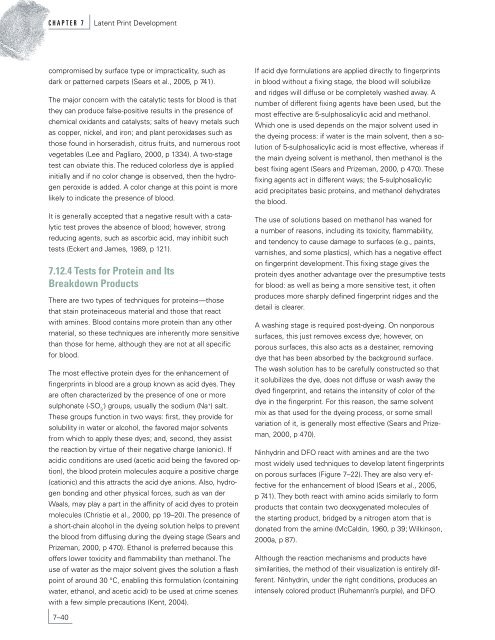Latent Print Development - National Criminal Justice Reference ...
Latent Print Development - National Criminal Justice Reference ...
Latent Print Development - National Criminal Justice Reference ...
You also want an ePaper? Increase the reach of your titles
YUMPU automatically turns print PDFs into web optimized ePapers that Google loves.
C H A P T E R 7 <strong>Latent</strong> <strong>Print</strong> <strong>Development</strong><br />
compromised by surface type or impracticality, such as<br />
dark or patterned carpets (Sears et al., 2005, p 741).<br />
The major concern with the catalytic tests for blood is that<br />
they can produce false-positive results in the presence of<br />
chemical oxidants and catalysts; salts of heavy metals such<br />
as copper, nickel, and iron; and plant peroxidases such as<br />
those found in horseradish, citrus fruits, and numerous root<br />
vegetables (Lee and Pagliaro, 2000, p 1334). A two-stage<br />
test can obviate this. The reduced colorless dye is applied<br />
initially and if no color change is observed, then the hydrogen<br />
peroxide is added. A color change at this point is more<br />
likely to indicate the presence of blood.<br />
It is generally accepted that a negative result with a catalytic<br />
test proves the absence of blood; however, strong<br />
reducing agents, such as ascorbic acid, may inhibit such<br />
tests (Eckert and James, 1989, p 121).<br />
7.12.4 Tests for Protein and Its<br />
Breakdown Products<br />
There are two types of techniques for proteins—those<br />
that stain proteinaceous material and those that react<br />
with amines. Blood contains more protein than any other<br />
material, so these techniques are inherently more sensitive<br />
than those for heme, although they are not at all specific<br />
for blood.<br />
The most effective protein dyes for the enhancement of<br />
fingerprints in blood are a group known as acid dyes. They<br />
are often characterized by the presence of one or more<br />
- + sulphonate (-SO ) groups, usually the sodium (Na ) salt.<br />
3<br />
These groups function in two ways: first, they provide for<br />
solubility in water or alcohol, the favored major solvents<br />
from which to apply these dyes; and, second, they assist<br />
the reaction by virtue of their negative charge (anionic). If<br />
acidic conditions are used (acetic acid being the favored option),<br />
the blood protein molecules acquire a positive charge<br />
(cationic) and this attracts the acid dye anions. Also, hydrogen<br />
bonding and other physical forces, such as van der<br />
Waals, may play a part in the affinity of acid dyes to protein<br />
molecules (Christie et al., 2000, pp 19–20). The presence of<br />
a short-chain alcohol in the dyeing solution helps to prevent<br />
the blood from diffusing during the dyeing stage (Sears and<br />
Prizeman, 2000, p 470). Ethanol is preferred because this<br />
offers lower toxicity and flammability than methanol. The<br />
use of water as the major solvent gives the solution a flash<br />
point of around 30 °C, enabling this formulation (containing<br />
water, ethanol, and acetic acid) to be used at crime scenes<br />
with a few simple precautions (Kent, 2004).<br />
7–40<br />
If acid dye formulations are applied directly to fingerprints<br />
in blood without a fixing stage, the blood will solubilize<br />
and ridges will diffuse or be completely washed away. A<br />
number of different fixing agents have been used, but the<br />
most effective are 5-sulphosalicylic acid and methanol.<br />
Which one is used depends on the major solvent used in<br />
the dyeing process: if water is the main solvent, then a solution<br />
of 5-sulphosalicylic acid is most effective, whereas if<br />
the main dyeing solvent is methanol, then methanol is the<br />
best fixing agent (Sears and Prizeman, 2000, p 470). These<br />
fixing agents act in different ways; the 5-sulphosalicylic<br />
acid precipitates basic proteins, and methanol dehydrates<br />
the blood.<br />
The use of solutions based on methanol has waned for<br />
a number of reasons, including its toxicity, flammability,<br />
and tendency to cause damage to surfaces (e.g., paints,<br />
varnishes, and some plastics), which has a negative effect<br />
on fingerprint development. This fixing stage gives the<br />
protein dyes another advantage over the presumptive tests<br />
for blood: as well as being a more sensitive test, it often<br />
produces more sharply defined fingerprint ridges and the<br />
detail is clearer.<br />
A washing stage is required post-dyeing. On nonporous<br />
surfaces, this just removes excess dye; however, on<br />
porous surfaces, this also acts as a destainer, removing<br />
dye that has been absorbed by the background surface.<br />
The wash solution has to be carefully constructed so that<br />
it solubilizes the dye, does not diffuse or wash away the<br />
dyed fingerprint, and retains the intensity of color of the<br />
dye in the fingerprint. For this reason, the same solvent<br />
mix as that used for the dyeing process, or some small<br />
variation of it, is generally most effective (Sears and Prizeman,<br />
2000, p 470).<br />
Ninhydrin and DFO react with amines and are the two<br />
most widely used techniques to develop latent fingerprints<br />
on porous surfaces (Figure 7–22). They are also very effective<br />
for the enhancement of blood (Sears et al., 2005,<br />
p 741). They both react with amino acids similarly to form<br />
products that contain two deoxygenated molecules of<br />
the starting product, bridged by a nitrogen atom that is<br />
donated from the amine (McCaldin, 1960, p 39; Wilkinson,<br />
2000a, p 87).<br />
Although the reaction mechanisms and products have<br />
similarities, the method of their visualization is entirely different.<br />
Ninhydrin, under the right conditions, produces an<br />
intensely colored product (Ruhemann’s purple), and DFO

















